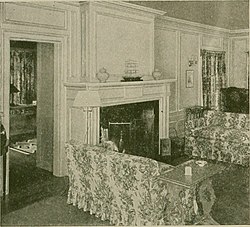Millwork

Millwork building materials are historically any woodmill-produced building construction interior-finish, exterior-finish, or decorative components. Stock profiled and patterned millwork building components fabricated by milling at a planing mill can usually be installed with minimal alteration.[1] Today, millwork also encompasses items that are made using alternatives to wood, including synthetics, plastics, and wood-adhesive composites.
Specifics
Millwork building materials include the ready-made carpentry elements usually installed in any building.[2] Many of the specific features of the space are created using different types of architectural millwork: doors, window casings, and cabinets to name just a few.[1][3] The materials used in millwork items today are most often graded-lumber, code compliant fasteners, various glasses, and other decorative coatings and finishes. Most millwork building materials can be installed with little or no modification as part of the construction process.[1]
Historical context

Historically, the term millwork applied to building elements made specifically from wood.[2] During the "Golden Age" of millworking (1880–1910), virtually everything in the house was made from wood.[3] During this time, the millwork produced in the United States became standardized nationwide.
Today, the increase in the use of synthetic materials has led many professionals to consider any item that is composed of a combination of wood and synthetic elements to also be properly defined as millwork. This includes products that make use of pressed-wood chips in the design, such as melamine coated shelving.[1]
Fabrication
There are two types of manufacturers of millwork goods. In one, referred to as "stock millwork", commodity fabricators mass-produce trims and building components—with the end product being low cost, interchangeable items for commercial or home builders. In another, the product is custom produced for individuals or individual building projects—usually a costlier option[4] which is referred to as "architectural millwork."[5]
Uses
Millwork building materials are used for both decoration and to increase the utility of buildings.[2]
Types
- "Built-in" room elements (bookcases, entertainment centers, etc.)
- Cabinetry
- Ceiling trims, embellishments, beams, and extensions
- Chair rails and wainscoting
- Columns and cornices
- Doors
- Door, window, and threshold moldings, sashes, and trims
- Fireplace mantels
- Stairway, stair parts, and balustrades
- Switch-plates and interior wall access points
- Wall crowns and baseboard moldings
- Wall covers, paneling, and corner beads
- Windows
References
- ^ a b c d Did you Know?; article at Wise Geek online; retrieved March 2013.
- ^ a b c History of Millwork; article; Creative Millwork Llc. website; retrieved June 2013
- ^ a b Historic Millwork: Re-creating Nineteenth–Mid-Twentieth Century Millwork...; Hull, Brent; excerpts online; Amazon.com; p. xi
- ^ Wood Components; Circle Trim webpage; retrieved March 2013.
- ^ Architectural Millwork; Dictionary of Construction online; accessed October 2015
